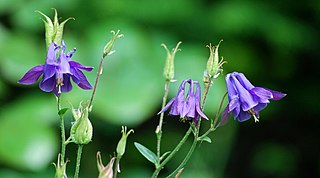
Aquilegia is a genus of about 130 species of perennial plants that are found in meadows, woodlands, and at higher elevations throughout the Northern Hemisphere, known for the spurred petals of their flowers.

Aquilegia formosa, the crimson columbine, western columbine, or (ambiguously) "red columbine", is a common wildflower native to western North America, from Alaska to Baja California, and eastward to Montana and Wyoming.

Aquilegia canadensis, the Canadian or Canada columbine, eastern red columbine, or wild columbine, is a species of flowering plant in the buttercup family Ranunculaceae. It is an herbaceous perennial native to woodland and rocky slopes in eastern North America, prized for its red and yellow flowers. It readily hybridizes with other species in the genus Aquilegia.
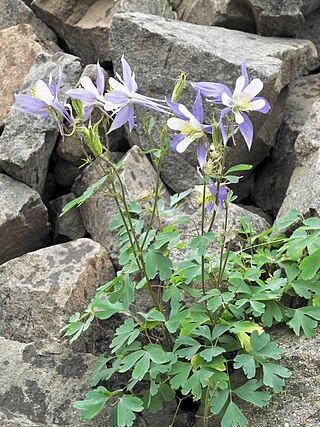
Aquilegia coerulea, the Colorado columbine, Rocky Mountain columbine, or blue columbine, is a species of flowering plant in the buttercup family Ranunculaceae, native to the Rocky Mountains and some of the surrounding states of the western United States. It is the state flower of Colorado. The Latin specific name coerulea means "sky blue".
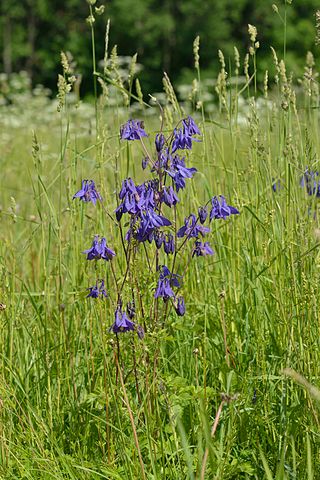
Aquilegia vulgaris is a species of columbine native to Europe with common names that include: European columbine, common columbine, granny's nightcap, and granny's bonnet. It is a flowering herbaceous perennial plant growing to 1.2 m tall, with branched, thinly hairy stems. The leaves are biternate; each leaf has three groups of three leaflets. The flowers, in various shades of purple, blue, pink and white, are pendent or horizontal with strongly hooked spurs, and appear in early summer.

Hyles lineata, also known as the white-lined sphinx, is a moth of the family Sphingidae. They are sometimes known as a "hummingbird moth" because of their bird-like size and flight patterns.
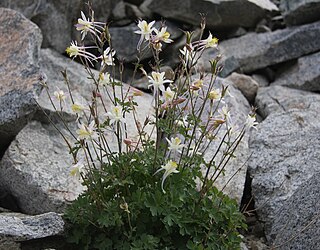
Aquilegia pubescens is a high-altitude species of columbine known by the common names Sierra columbine, alpine columbine and Coville's columbine. Its flowers are large and usually a creamy white.

Lilium parryi, common name lemon lily, is a rare species of lily.
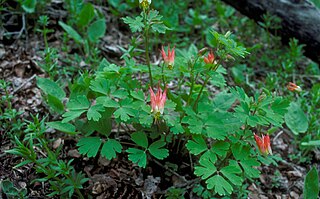
Aquilegia elegantula, the western red columbine, is a perennial species of plant in the family Ranunculaceae, native to the Southwestern United States and northern Mexico.
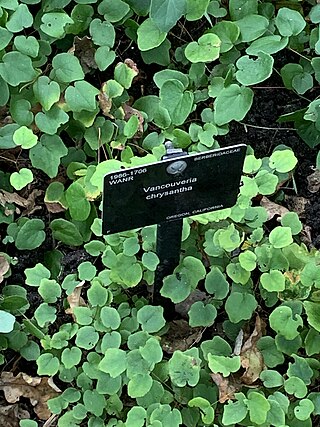
Vancouveria chrysantha is a species of flowering plant in the barberry family known by the common names golden inside-out flower and Siskiyou inside-out flower.
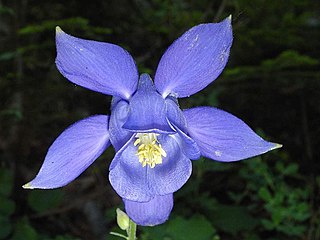
Aquilegia bertolonii, common name Bertoloni columbine or Bertoloni's columbine, is a perennial species of flowering plant in the family Ranunculaceae, native to Italy, southern France, and Slovenia.

Aquilegia pyrenaica, common name Pyrenean columbine, is a species of flowering plant in the family Ranunculaceae. It is endemic to the Pyrenees where it grows on grassland and in rocky places. It was first described in 1805 by Augustin Pyramus de Candolle who gave it the name Aquilegia pyrenaica.

Aquilegia longissima, the long-spur columbine, is a rare perennial herb that is native to northern Mexico, Trans-Pecos Texas and southern Arizona. In the original species description by Asa Gray in 1883, Aquilegia longissima is distinguished from the shorter-spurred golden columbine Aquilegia chrysantha based on the extremely long spur over 10 cm long, narrow spatulate petals and very slender spurs that usually hang straight down. The petal spurs have been known to reach 16 cm in length, the longest nectary spurs of any Eudicot. The plants typically flower in the fall after monsoon rains and are found in oak-pine-juniper woodlands in shaded canyons near intermittent streams or on talus slopes.
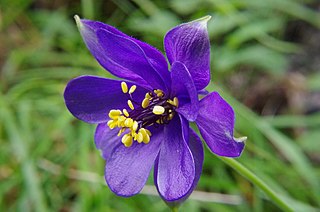
Aquilegia alpina, the alpine columbine or breath of God, is a perennial species of flowering plant in the family Ranunculaceae, native to the western and central Alps.

Aquilegia barnebyi, commonly known as the oil shale columbine or Barneby's columbine, is a perennial species of flowering plant in the buttercup family, with a native range comprising northeastern Utah and northwestern Colorado in the United States. It is named after Rupert Charles Barneby, who, with Harry Dwight Dillon Ripley, first discovered it in Colorado.

Aquilegia ecalcarata, the spurless columbine or false columbine, is a perennial species of flowering plant in the family Ranunculaceae, native to central China.

Aquilegia buergeriana is a perennial species of flowering plant in the family Ranunculaceae, native to Japan.

Aquilegia desertorum, the desert columbine, is a perennial species of flowering plant in the family Ranunculaceae, native to the southwestern United States.

Aquilegia desolaticola, the desolation columbine or Desolation Canyon columbine, is a perennial species of flowering plant in the family Ranunculaceae, endemic to Utah.

Aquilegia micrantha, the Mancos columbine or Bluff City columbine, is a perennial species of plant in the family Ranunculaceae, native to Utah, Colorado, and Arizona.




















